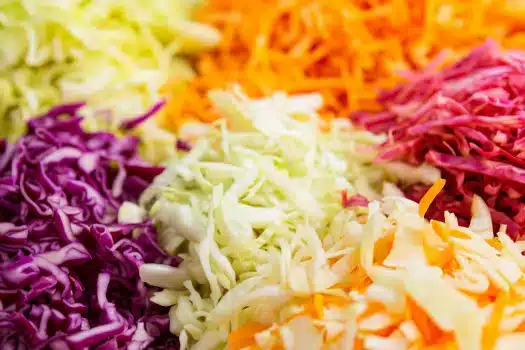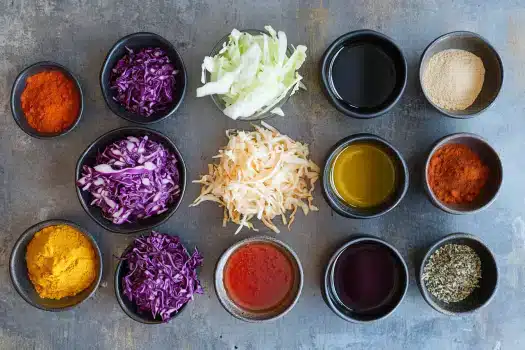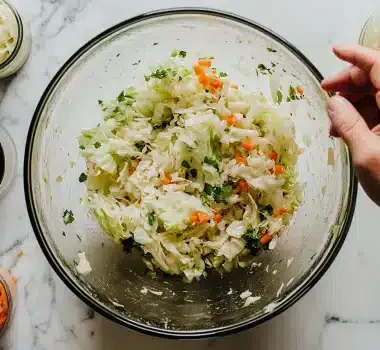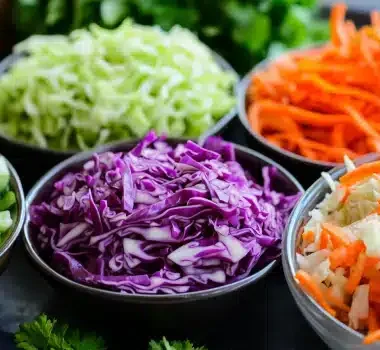Have you ever found yourself in the middle of making curtido and realized you’re missing a key ingredient? Don’t worry! The beauty of this Central American pickled cabbage lies in its flexibility. In this comprehensive guide, we’ll explore a variety of curtido recipe substitutions, giving you the confidence to adapt the recipe to your needs, preferences, and what you have readily available in your kitchen. We’ll cover everything from cabbage and vinegar swaps to spice and herb alternatives. This guide is your gateway to a world of flexible pickling! Get ready to discover how to make delicious curtido every time.
Understanding the Basics of a Curtido Recipe
Before we dive into the exciting world of curtido recipe substitutions, it’s crucial to understand what forms the foundation of a traditional recipe. Knowing the core components will make it easier to identify what ingredient swaps you can use and how they will affect the end result. Let’s get started.
Core Components of a Traditional Curtido
A traditional curtido recipe centers around a few key ingredients. Cabbage (usually green) forms the bulk of the mixture. Vinegar provides the essential acidity that pickles the vegetables, giving it the distinctive tang. Onions and carrots add flavor and texture. Spices like oregano, salt, and pepper enhance its overall profile, with some adding extra chili flakes for a spicy kick. Each of these ingredients contributes in its own way to the unique curtido flavor and texture, so it is important to understand what makes it that good.
Why Knowing Substitutions is Helpful
Knowing recipe substitutions is like having a secret weapon in the kitchen. Sometimes you are just missing one ingredient, but you still want to cook that recipe, and that’s where the substitutions come in. Also, this flexibility allows you to adapt recipes to different tastes or dietary restrictions. Understanding ingredient swaps gives you freedom to get creative and make curtido your own way. That way you will enjoy a great dish while using what you have available. This gives you the ability to create great meals.
Cabbage Substitutions in Curtido
Cabbage is the star of curtido, but what if you don’t have it on hand? Luckily, several other vegetables can step in to give you similar results. Understanding these cabbage alternatives will open doors to new textures and flavors.
Alternative Cabbage Varieties
While green cabbage is traditional, you can certainly use other cabbage varieties in your curtido. Red cabbage, for example, gives a beautiful color and a slightly different flavor. Napa cabbage provides a more delicate texture and flavor. These changes in your main ingredient can make a world of difference and transform your pickled cabbage into something new. These substitutions can add a layer of complexity to your curtido.
Using Other Leafy Vegetables
If you’re out of cabbage, don’t worry, there are options. You can try other leafy greens like kale or collard greens. These greens add more nutrients to your curtido, and also offer a unique taste and texture profile. Be sure to finely chop these greens before adding them, so they can have the proper texture in the curtido. This will give you another opportunity to explore a different approach to making curtido.
Blending Different Vegetables
Another approach is to mix different cabbage varieties. Combining green and red cabbage is always a good choice. You can also add other crunchy vegetables like cauliflower for texture, or use any vegetable you like. This will give a great combination of textures and flavors, and will make your curtido special. These tips give you another way to use ingredient replacements in your recipe.
Vinegar Substitutions in Curtido
Vinegar is key to pickling, but there are options in case you don’t have it, or just want to experiment. Understanding different vinegar substitutions is essential if you want to explore new flavor profiles.
Different Types of Vinegar
While white vinegar is often used, you can explore other types of vinegar. Apple cider vinegar gives a milder flavor and a hint of sweetness. Rice vinegar is another great option, bringing a delicate and slightly sweet flavor. Using different kinds of vinegar can create unique flavor nuances. The vinegar is a key component, but the different variations are amazing to explore.
Using Citrus Juices
For a brighter, tangier twist, you can try using lemon or lime juice as a vinegar substitute. These juices introduce a fresh and zesty flavor to the curtido. Keep in mind that citrus juices won’t provide the same preservative effect as vinegar, so be sure to consume the curtido within a couple of days. This will add a unique flavor profile and will offer different results.
Other Acidic Liquids
Besides vinegar and citrus juice, you can use other acidic liquids like the brine from other pickled vegetables or even some types of fermented beverages. Always make sure they are safe for consumption and that they have an acidic profile similar to vinegar. This gives you a lot of options when making a homemade pickle. This way you will experiment and create new flavor combinations.
Onion and Carrot Substitutions in Curtido

Onions and carrots are key components of curtido, and they give great texture and flavor. However, if you are missing one, you have some ingredient replacements to choose from.
Alternative Alliums
If you don’t have yellow onions, try using red onions or shallots instead. Red onions add a bit more sharpness, while shallots are milder and have a hint of sweetness. These onion alternatives can enhance your curtido and make it even more interesting. Each different onion can bring a new level of complexity.
Carrot Alternatives
You can use other root vegetables like radishes or jicama. Radishes provide a peppery crunch, while jicama offers a sweeter, nuttier flavor. These carrot substitutes can enhance your cabbage slaw and give a new texture and layer of flavor. Remember that using recipe substitutions allows you to customize your meals.
Incorporating Other Crunchy Vegetables
You can also add bell peppers or cucumbers to add more texture and flavor to your curtido. Bell peppers offer a bit of sweetness and a bright color, and cucumbers add a refreshing element. These additions are always a great choice when you are experimenting with pickled cabbage. Feel free to explore different vegetables and find the ones that you prefer the most.
Spice and Herb Substitutions for Curtido
Spices and herbs play a big part in the flavor profile of curtido, but you can easily adapt the recipe to suit your taste using some smart spice swaps.
Swapping Spices
You can adjust the level of spiciness by adding or removing chili flakes. If you want to make it spicier, you can add a pinch of paprika or even cayenne pepper. If you want to keep it mild, then just add a tiny bit of pepper. You can customize your curtido to match your spice preferences, so be sure to explore. This is just a great way to be flexible in the kitchen and also adapt any recipe.
Alternative Herbs
You can experiment with different herbs to change the taste of the curtido. Instead of dried oregano, try using fresh oregano, or use a combination of other fresh herbs like thyme or cilantro. These different approaches to herb substitutes will make your curtido special and unique. This flexibility is great to create new and different meals.
Using Seed Combinations
You can also add other seeds to your curtido to give it a different layer of flavor and texture. Try adding some celery or mustard seeds. These seeds will give you another kind of flavor, and also a new crunch. This will make your dish more interesting. Adding different seeds will give a unique flavor profile, and will allow you to create your own version of curtido.
Curtido Variations and Flavor Adjustments

Now, let’s take a look into how you can adjust the main elements in curtido to create a unique flavor profile. You can modify the level of sweetness, the level of tanginess, or just combine ingredients in a different way.
Adjusting the Level of Sweetness
If you prefer a sweeter curtido, you can add a touch of sugar, honey, or maple syrup. You should always start with small amounts and then add more if you wish. This is because it is always easier to add, than to subtract. This is great when you are experimenting in the kitchen, as you can have great results.
Adjusting the Tanginess
The level of tanginess can be adjusted to your own liking. If you like it more tart, you can increase the amount of vinegar, or ferment for a longer time. If you prefer less tang, then use less vinegar and ferment for less time. Always remember that less is more, and you can always add more as you taste it. This level of flexibility is what makes a great cook.
Creating Unique Flavor Profiles
You can easily create your own version of curtido by trying unique combinations of ingredients and spices. For example, you can add roasted peppers, garlic or different seeds. You can also use different combinations of vinegar to create unique flavor notes. The sky is the limit, so feel free to explore and create something that you love. This is all about making a personalized dish that you will enjoy.
Benefits of Curtido
Beyond its delicious taste and versatility, curtido offers a range of health benefits, making it more than just a tasty side dish. The fermentation process, combined with the fresh vegetables, creates a nutritional powerhouse that can contribute to your overall well-being. Understanding these benefits can further enhance your appreciation for this Central American staple.
Rich in Nutrients
The vegetables used in curtido, such as cabbage, carrots, and onions, are packed with essential vitamins and minerals. Cabbage, a cruciferous vegetable, is a great source of vitamin C and vitamin K, which are vital for immune function and blood clotting. Carrots are rich in beta-carotene, which the body converts into vitamin A, important for vision and skin health. Onions provide antioxidants and have anti-inflammatory properties. The combination of these vegetables makes curtido a nutrient-dense addition to any diet. This blend is not just flavorful, but also provides a variety of health benefits, as these vegetables have been known for centuries. This makes it a great addition to your meals. The nutrients are also enhanced by the fermentation process, which also gives the dish other properties.
Probiotic Powerhouse
Curtido, like other fermented foods, is a great source of probiotics. These beneficial bacteria help maintain a healthy balance in your gut microbiome, which is important for digestion, immune function, and even mental health. The fermentation process breaks down the sugars in the vegetables, creating a tangy flavor and producing these beneficial microorganisms. Including curtido in your diet can improve your gut health and support overall wellness. The probiotics are a great addition to your diet, and will improve your digestive process. These are the main benefits of including a fermented vegetable in your meals. This is one of the reasons why curtido is so popular around Central America.
Digestive Aid
The combination of fiber from the vegetables and probiotics from the fermentation process makes curtido an excellent digestive aid. Fiber helps with regular bowel movements, while probiotics contribute to a healthy gut environment that improves digestion and nutrient absorption. Additionally, the enzymes produced during fermentation can aid in breaking down complex compounds, making them easier for your body to digest. By including this pickled cabbage in your meals you will have a great contribution to a healthy and balanced diet. These are the main digestive benefits of including curtido in your diet, so it is a great option to explore. This is why this dish has been a staple in the region for many years.
Step-by-Step Preparing Curtido
Creating curtido at home is a straightforward process that requires just a few simple steps. Once you have your ingredients and understand the basic process, you’ll find it incredibly easy to create a batch of this tangy side dish. This step-by-step guide ensures that, even if you are new to pickling, you’ll be able to achieve a delicious and authentic result.
Gathering Your Ingredients
Begin by gathering all the necessary ingredients. You will need fresh green cabbage, carrots, and onions. Choose high-quality produce for the best flavor and texture. You should also have white or apple cider vinegar, oregano, salt, and black pepper, as well as chili flakes if you like it spicy. Always be sure that all the ingredients you are using are fresh and ready to be used. This will guarantee the best flavors and will make a better cabbage slaw. This step is often overlooked, but is key to success.
Preparing the Vegetables
Now it is time to prep all the vegetables for the pickling process. Thinly shred the cabbage, and cut the carrots into matchsticks or small circles. Slice the onions into thin half-moons. The way you cut the vegetables will affect the overall texture, so be sure to cut them in a way you prefer. Combine all the shredded vegetables in a large bowl, and set aside. The next process is about creating the brine, which is also essential for a great result. All these small details will make the biggest difference.
Creating the Brine and Fermenting
In a separate bowl, whisk together the vinegar, salt, oregano, pepper and chili flakes (if using). Pour the brine over the mixed vegetables, making sure everything is well coated. Massage it lightly with clean hands to ensure that the brine is distributed evenly. Pack the mixture into a clean glass jar, pressing down firmly to remove any air pockets, and cover it loosely with a lid. Let the curtido ferment at room temperature for 1 to 3 days, tasting it daily to check the tanginess. When ready, store it in the refrigerator for up to two weeks. This is a relatively easy process that requires patience and attention.
You can find more cooking tips in sites like www.sublimecake.com www.foodnetwork.com
Curtido Recipe Substitutions FAQs
To wrap up, let’s look into some of the frequently asked questions about curtido recipe substitutions. This is all about giving you some extra help, and making it easier for you to understand all about curtido.
Common Questions About Curtido Substitutions
- FAQ 1: Can I use red cabbage in place of green cabbage for curtido?
Yes, red cabbage is a great alternative, adding color and a slightly different flavor. - FAQ 2: What’s a good substitute for white vinegar in a curtido recipe?
Apple cider vinegar or rice vinegar are excellent options for a milder tang. - FAQ 3: Can I make curtido without onions?
Yes, you can use shallots or other alliums for a similar flavor. - FAQ 4: What can I use instead of carrots in my curtido?
Radishes or jicama provide a similar crunch and flavor. - FAQ 5: How do different spice substitutions affect curtido’s flavor?
Different spices will alter the aroma and spice profile, so be sure to experiment. - FAQ 6: Can I make curtido without sugar?
Yes, it is usually made without sugar, but you can add some if you want a sweeter flavor. - FAQ 7: How can I adjust the tanginess of my curtido?
Increase or decrease the vinegar or fermentation time to modify the level of tanginess.
Conclusion
Curtido is a testament to the deliciousness that can come from simple, versatile ingredients. By mastering curtido recipe substitutions, you’re not only making it more adaptable but also opening up a world of flavors and textures. So, go ahead, get creative in the kitchen, and make curtido your own, while enjoying the process of flexible pickling.






